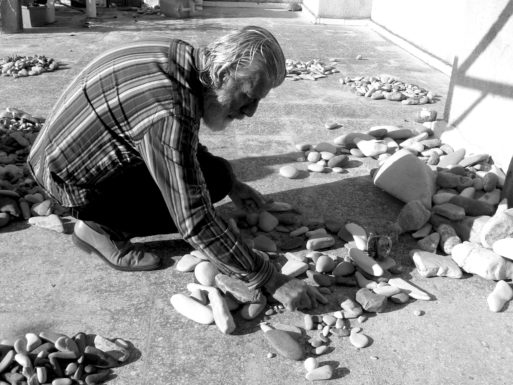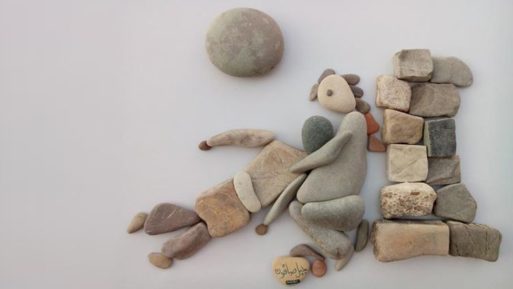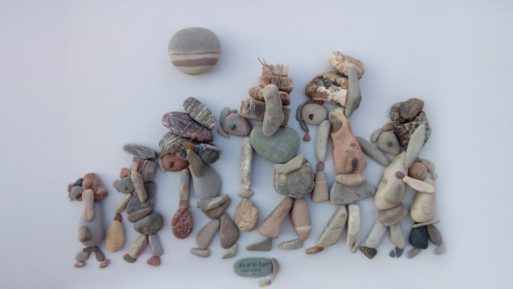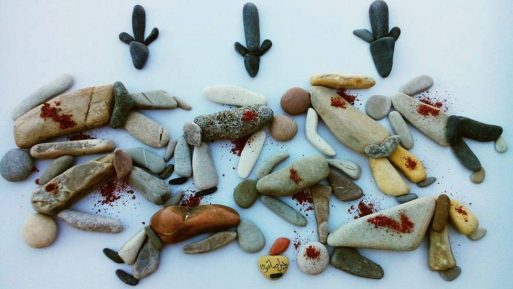
Nizar Ali Badr
Credit: syriancreativehavens.com
Nizar Ali Badr is a sculptor who lives and works in Lattakia, Syria. For over three decades, he has collected pebbles from the Mediterranean seacoast at the foot of Mount Zaphon and turned them into miniature sculptures depicting scenes from his homeland. During years past, he glued the tiny, richly colored pebbles to cards to preserve his work. But today, in the midst of Syria’s six-year civil war, glue has become too expensive. So he photographs his works to preserve them. And then, like so many of the lives they represent, they are gone.
“…when I create a stone sculpture,” Ali Badr says, “I know with certainty that there is nothing there to hold it together. It will, undoubtedly, be destroyed in time… Because of this, there is an ephemeral character inherent in my work that requires an ability to let go of attachment to material items and to understand the temporal nature of all things in life.”

Credit: Nizar Ali Badr via BBC.com
That’s a sentiment that has served the sculptor well for the past six years, as he has been forced to bear witness to the devastation of his homeland. Today he works alone in his studio, his “museum” as he calls it, with no electricity. “Being alone makes me feel aligned and peaceful,” Ali Badr explains. And though he lives in poverty because of the war, he never tires of his work. “My inspiration comes from my profound love for the Zaphon stones and for my homeland Syria.”
And it’s apparent that Ali Badr’s connection to the stones and pebbles he uses to make his art is profound. In ancient Syrian culture, Mount Zaphon, also known as Djebel Al Aqra, was the home of Baal, the god of mountains, storms and rain. It is a sacred place, and the place that gave birth to young Nizar’s dream many years ago.

Credit: Nizar Ali Badr via BBC.com
“…My dream [was] to reach people’s hearts and deliver a message. As my passion for stone sculptures evolved, I heard the call and the cry of the stones,” Nizar says.
“The cries came out of the uterus of the holy Syrian land. The stones screamed so loudly that all resounded…the cries of the needy, the oppressed and the fugitives,” he goes on.
And, indeed, Ali Badr’s work speaks volumes to the vast suffering of the Syrian people. Despite their simplicity, the sculptures are imbued with so much raw emotion that their impact is devastating. There are images of refugee families, bent under the weight of their belongings as they flee their homes. There are images of mothers comforting their children and neighbors holding each other in despair. And there are images of violence and death.

Credit: Nizar Ali Badr via BBC.com
There are also images that depict happier times — children playing under a tree or flowers in a vase. Perhaps they are Ali Badr’s way of staying connected to a time when life was not so difficult. Or maybe they are a prayer for the future. It’s hard to know.
One thing is certain, however. And that is Ali Badr’s commitment to communicating the vastness of Syria’s suffering to the rest of the world.
“My human message is the spreading of happiness, amity and love,” he explains. “Inside of the war, destruction, death, migration, exodus, chaos, poverty, injustice, there are screams and yells of human beings as pain and suffering gripped them. Through my creations one can hear the stones screaming and yelling in desperate imploring: ‘Stop killing human beings, stop destruction, do not abandon your humanity!'”
Regardless of one’s political affiliation or beliefs, it is impossible to look at the work of Nizar Ali Badr and not feel the same way.

 The Stunning Pebble Art of Nizar Ali Badr
The Stunning Pebble Art of Nizar Ali Badr


 “As Tears Go By” by Marianne Faithfull
“As Tears Go By” by Marianne Faithfull

 Funeral Favors Offer Visitors a Tangible Memento
Funeral Favors Offer Visitors a Tangible Memento















